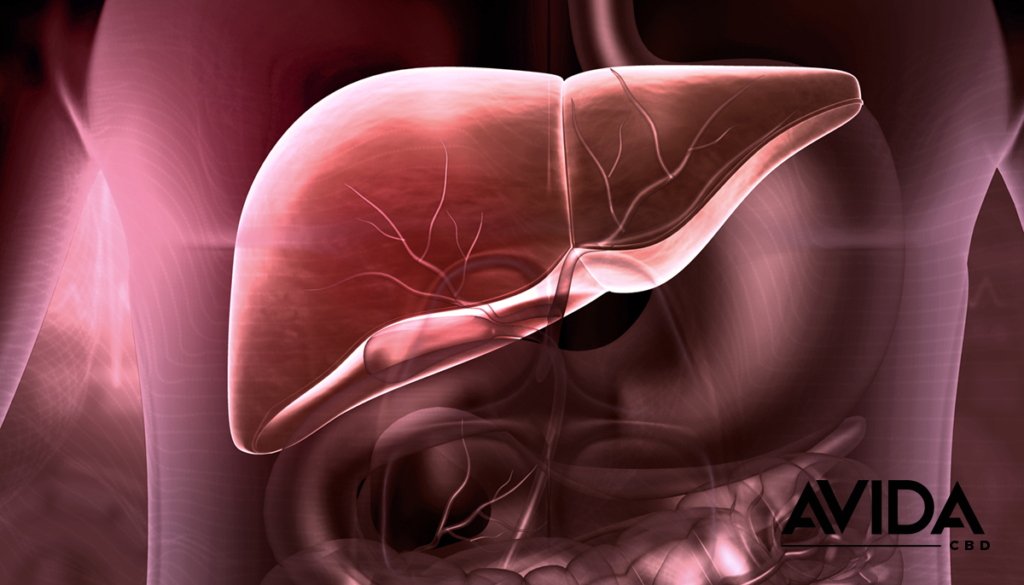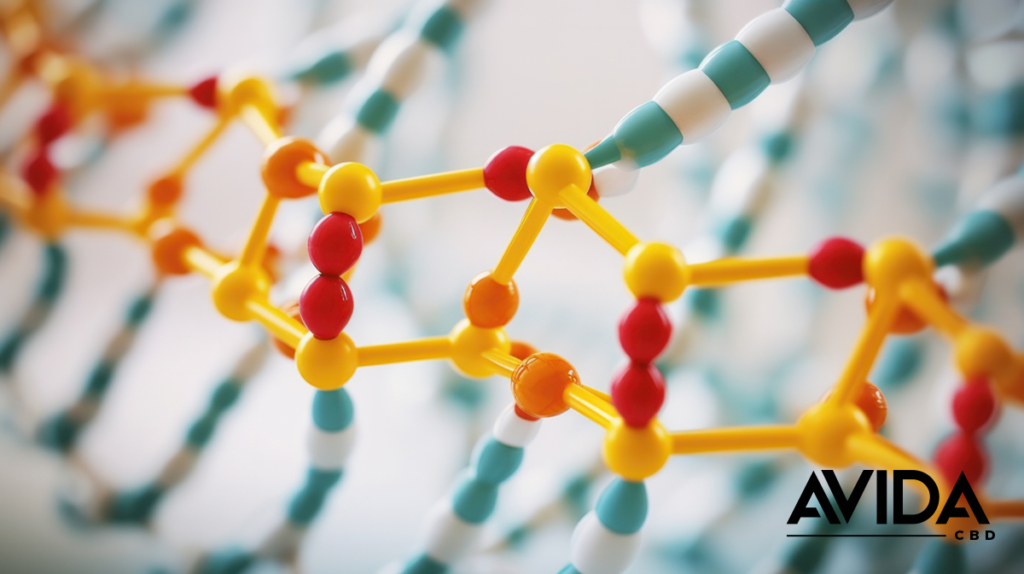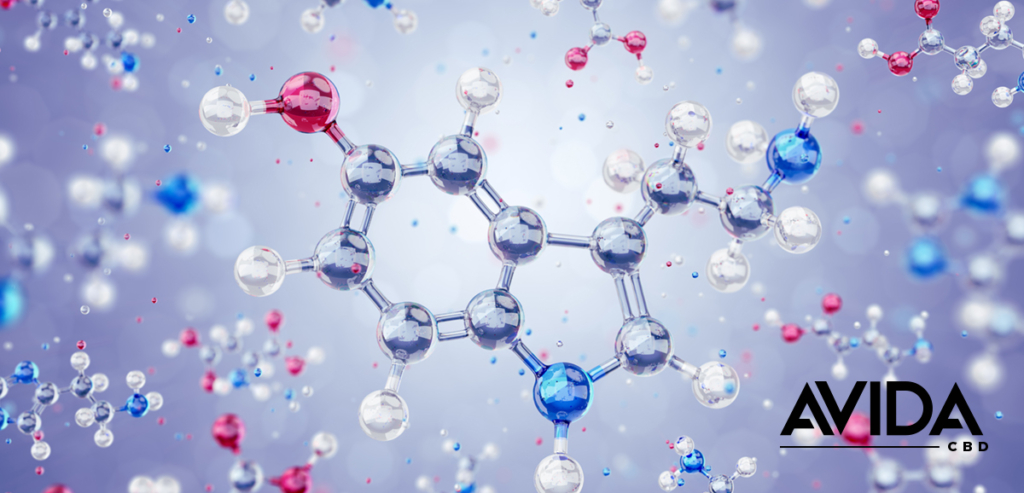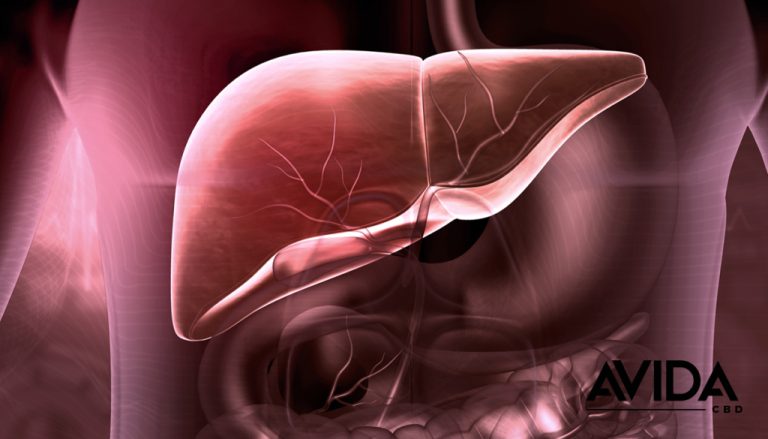When you take CBD, your body breaks it down into different substances called metabolites. When CBD is metabolized, the specific metabolites it produces play a large role in CBD’s therapeutic potential and safety [1].
In this guide, you’ll learn all about the changes that happen to CBD inside your body so you have a better idea of how it works. By exploring how the body processes CBD without going too deep into the complex science stuff, you’ll gain deeper insight into how CBD really affects you and your overall well-being.
Key Takeaways
- CBD metabolism takes place in the liver, where the cannabinoid produces numerous metabolites that contribute to its potential therapeutic effects [2].
- The metabolism of CBD happens in two distinct phases: in the first, CBD metabolizes into various metabolites, and in the second, metabolites are eliminated from the body [3].
- The type of consumption method significantly influences CBD pharmacokinetics and its metabolites, as it plays a large role in CBD absorption, distribution, metabolism, and excretion [4].
 CBD’s journey in the body is complex. CBD metabolites studies reveal more than 100 metabolites of CBD have been discovered to date [5]. Intricate and diverse, the process by which CBD is metabolized in the body is still being studied for its therapeutically promising pharmacological effects.
CBD’s journey in the body is complex. CBD metabolites studies reveal more than 100 metabolites of CBD have been discovered to date [5]. Intricate and diverse, the process by which CBD is metabolized in the body is still being studied for its therapeutically promising pharmacological effects.
When the chemical structure of CBD was first determined in 1963, researchers discovered CBD creates major metabolites. After decades of cannabinoid research, today it’s clear these metabolites play a huge role in CBD’s effects.
One of the abundant metabolites of CBD is CBD-7-oic acid (7-COOH-CBD). This is followed by 7-OH-CBD and then CBD. The whole process of CBD metabolism starts in the liver. Here, it’s influenced by enzymes known as cytochrome P450, which play a crucial role in breaking down CBD into various metabolites [1].
A better understanding of CBD metabolism and how CBD metabolites are formed offers deeper insight as to how CBD works. It offers a clearer picture of how CBD transforms into different metabolites and how these metabolites interact with the body to ultimately influence CBD’s therapeutic potential. Here’s how it works.
The Hydroxylation and Oxidation Process of CBD
When CBD is processed, it goes through a series of changes in your body. A major process is known as hydroxylation, involving a group of enzymes called cytochrome P450 (CYP450) [3]. This enzyme family plays a huge role in drug metabolism.
An enzyme known as CYP3A4 is responsible for the hydroxylation process, turning CBD into a metabolite called 7-hydroxycannabidiol (7-OH-CBD) [6]. Cytochrome P450-Catalyzed Metabolism of Cannabidiol to the Active Metabolite 7-Hydroxy-Cannabidiol [6]. Each metabolite produced as a result of hydroxylation and oxidation plays a different role in the body.
Understanding these processes offers deeper insight about how CBD changes into different forms. It’s these various CBD formulations, after all, that hold the key to its potential therapeutic effects [1].
The Two Phases of CBD’s Metabolic Journey
CBD’s metabolic journey happens in two phases: Phase I and Phase II. Both play a crucial role in the process in their own unique way.
Phase I metabolism involves enzymatic transformations primarily mediated by cytochrome P450 (CYP450) enzymes, including CYP2C9, CYP2C19, CYP3A4, and others [7]. These transformations typically involve hydroxylation, yielding metabolites that generally retain pharmacological activity [3].
In Phase II metabolism, something known as conjugation occurs. It makes CBD metabolites more water-soluble so they can be successfully excreted from the body [3].
Both Phase I and Phase II metabolism are complex processes essential for the transformation of CBD into various metabolites and their safe elimination from the body.
Out of all CBD metabolites, certain ones have gained more attention than others. The most noteworthy of these are 7-OH-CBD and 7-COOH. Both are believed to have a profound influence on the way CBD works within the body, each contributing to the cannabinoid’s varied effects [1].
Each metabolite has its unique characteristics, interactions in the body, and potential effects. Understanding a bit more about each one offers an even better understanding of CBD.
7-OH-CBD
 One of the most important metabolites of CBD’s transformation is 7-hydroxy-CBD (7-OH-CBD). It’s the primary active CBD metabolite and goes through increased Phase II reactions that enhance its water solubility for excretion [8].
One of the most important metabolites of CBD’s transformation is 7-hydroxy-CBD (7-OH-CBD). It’s the primary active CBD metabolite and goes through increased Phase II reactions that enhance its water solubility for excretion [8].
There’s preliminary research that supports 7-OH-CBD may contain similar anticonvulsant properties to CBD, help support healthy blood concentrations, inhibit the FAAH enzyme, and prevent the uptake of anandamide [9].
There’s also evidence to show that 7-OH-CBD may be slightly less effective than CBD in blocking the binding of THC to CB1 receptors [10]. So, while 7-OH-CBD might have some potential therapeutic benefits, they’re different than CBD.
Understanding more about 7-OH-CBD adds to the larger story of CBD’s therapeutic potential. It shows how complicated CBD’s changes in the body are and highlights how different applications could have different therapeutic outcomes.
7-COOH-CBD
Another major metabolite of CBD is CBD-7-oic acid (7-COOH-CBD). Along with its derivatives, 7-COOH-CBD makes up about half of the identified metabolites [1]. This means the role this metabolite plays in CBD’s human cannabinoid pharmacokinetics profile is significant.
7-COOH-CBD undergoes additional oxidation compared to other metabolites [1]. Ultimately, this results in various complex metabolic byproducts believed to lend to the varied effects of CBD.
 The cannabinoid pharmacokinetics of CBD and its metabolites (aka the way they move through the body) play a major role in how effective CBD is [8]. Things like consumption method, administration, genetics, and enzyme expression variations all influence this process.
The cannabinoid pharmacokinetics of CBD and its metabolites (aka the way they move through the body) play a major role in how effective CBD is [8]. Things like consumption method, administration, genetics, and enzyme expression variations all influence this process.
The absorption of CBD is largely influenced by the method of administration [11]. CBD is fat-soluble, meaning the bioavailability of CBD can increase when it’s ingested with a high-fat meal compared to an empty stomach [12]. Oral consumption of things like gummies and other edibles results in decreased bioavailability because they must first pass through the digestive tract and liver in a process known as the first-pass effect [13].
CBD metabolism is another significant part of its pharmacokinetic profile. The primary CBD metabolic enzymes are P450 enzymes CYP3A4 and CYP2C9 [6]. Ultimately, it’s these enzymes that lead to the creation of various metabolites.
In the end, CBD is predominantly excreted through the feces, as well as urine to a lesser extent [5]. Gaining a grasp of CBD pharmacokinetics can aid in the fine-tuning of your personal CBD routine to achieve the best results based on your unique needs.
Different Consumption Methods Play a Huge Role in CBD Metabolism
How CBD is consumed has a huge influence on bioavailability and pharmacokinetics. For instance, inhalable methods, like vaping or smoking CBD, offer increased bioavailability compared to oral and sublingual products. CBD pills and capsules display lower bioavailability [14].
Sprays or lozenges are sometimes used for oral and sublingual delivery of oil-based extracts. These products typically result in less pharmacokinetic variability [15]. There’s also evidence that shows using unheated cannabis extracts and rectal products may affect the uptake and metabolism of CBD differently [1].
Topical CBD products don’t typically reach the bloodstream [16]. Instead, they act locally where they’re applied, meaning CBD isn’t metabolized by the body when applied to the skin.
CBD’s Potential Interaction with Other Drugs
CBD and its metabolites can interact with other drugs, potentially influencing how they work and their effectiveness [17]. Variations in enzyme expression play an important role in these interactions, leading to differences in the pharmacokinetics and therapeutic responsiveness to CBD.
Some CBD metabolites inhibit P450 enzymes, which are critical in drug metabolism [18]. 7-OH-CBD inhibits nicotine metabolism, which is one reason CBD shows potential for tobacco dependence [19]. The influence of CBD and its metabolites on P-glycoprotein transporters may also affect the pharmacokinetics of various medications [1].
The potential interactions of CBD metabolites with other drugs are important to consider, especially if you’re taking other medications.
CBD metabolites may contain some real promise when it comes to supporting wellbeing. The myriad of potential therapeutic effects CBD contains can be attributed to how the cannabinoid is metabolized in the body [1].
There’s a growing body of research that suggests CBD and its metabolites may support anxiety, mental health, mood, sleep, inflammation, pain, cardiovascular health, movement, and more [20]. It all comes down to the way CBD metabolites influence various pathways. This includes FAAH activity and interactions with CB1, TRPV1, PPARs, and 5-HT1A receptors [21].
CBD metabolites’ diverse roles in health and disease are promising, but more research is needed to fully comprehend CBD’s therapeutic potential. However, some preclinical research has provided valuable insights into the potential biological activity of CBD metabolites.
Research shows CBD, as well as CBD 7-OH and 7-COOH metabolites, don’t bind directly with CB1 and CB2 receptors [22]. Instead, they activate a receptor called the type-1 vanilloid receptor. CBD and its 7-OH stop fatty acid amide hydrolase (FAAH) and slow down the uptake of anandamide but 7-COOH does not [23]. This shows that different CBD metabolites can act differently with receptors and enzymes.
Animal studies offer a bit more information on how different CBD metabolites work. One study showed the metabolite 10-OH-CBD was effective at reducing interocular eye pressure [1].
One study found that 7-COOH-CBD slightly decreased body temperature and displayed a minimal reduction in gut movement [1]. On the other hand, cannabielsoin, another possible CBD metabolite, showed zero effect on body temperature or digestion [1].
These findings demonstrate not all CBD metabolites share the same biological activity. This shows how diverse CBD metabolites and their potential effects are, leading to an increased understanding of how the effects of different cannabis extracts may vary.
Unfortunately, there’s a lack of studies that specifically address the biological activity of CBD metabolites in humans. There’s also little information on the human pharmacokinetics of CBD metabolites. The need for further studies is clear, which would offer an increased understanding of the way CBD metabolites work and their potential therapeutic effects.
The study of CBD and its various metabolites offers increased insight into the cannabinoid’s various effects, but challenges still remain. More research is necessary to fully grasp the clinical significance and therapeutic potential of CBD metabolites for various medical conditions.
It’s only with a better understanding of CBD metabolites that new therapeutic agents can be created. Current research shows the future is promising, but there are still several unknowns when it comes to CBD metabolite pharmacokinetics, drug interactions, and specific therapeutic effects.
Questions about the best way to analyze CBD metabolites also exist. Accurate and reliable analytical techniques are necessary to identify and measure their effectiveness. Understanding the possible drug interactions of CBD metabolites and other medications is also important. This ensures CBD is used safely with the best possible results.
Clinical trials are the best way to establish the safety, efficacy, and optimal dose. While human research is still limited, there is hope on the horizon. Pharmaceutical-sponsored clinical trials, like those by GW Pharma Ltd., are exploring the therapeutic potential of CBD in treating epilepsy and other medical conditions [24].
There’s also a need for long-term safety studies. Clinical trials are also necessary to understand how specific CBD formulations enhanced for better bioavailability work in the body, and how this may help support a wide range of health problems. These trials are critical to ensure the safety and efficacy of CBD therapy, especially when it comes to long-term use.
Wrapping Up
The journey of CBD through the body is made up of complex metabolic processes and transformations. Once CBD is consumed, it undergoes intricate changes, resulting in a diverse array of metabolites [1]. Each of these contains distinct properties that are suggested to contribute to CBD’s vast therapeutic potential [25].
More research is needed to fully understand the potential clinical significance of CBD and its metabolites on various health conditions. The future, however, looks promising. With increasing research, experts are discovering an increased understanding of the various possibilities CBD metabolites contain.
Frequently Asked Questions
What are the major metabolites of CBD?
The major metabolites of CBD are 7-OH-CBD and 7-carboxy-CBD. 7-OH-CBD is the main pharmacologically active metabolite [8].
What enzymes metabolize CBD?
CBD is metabolized by the P450 enzyme family, which includes CYP1A1, CYP1A2, CYP2C9, CYP2C19, CYP2D6, CYP3A4, and CYP3A5 [16].
How and where does CBD metabolism occur?
CBD metabolism occurs primarily in the liver, where cytochrome P450 enzymes regulate the process and produce metabolites through hydroxylation and oxidation reactions [3].
1. Ujváry, I., & Hanuš, L. (2016). Human Metabolites of Cannabidiol: A Review on Their Formation, Biological Activity, and Relevance in Therapy. Cannabis and Cannabinoid Research, 1(1), 90–101. https://doi.org/10.1089/can.2015.0012
2. Watanabe, K., Usami, N., Osada, S., Narimatsu, S., Yamamoto, I., & Yoshimura, H. (2019). Cannabidiol metabolism revisited: tentative identification of novel decarbonylated metabolites of cannabidiol formed by human liver microsomes and recombinant cytochrome P450 3A4. Forensic Toxicology, 37(2), 449–455. https://doi.org/10.1007/s11419-019-00467-0
3. Smith, R. T., & Gruber, S. A. (2023). Contemplating cannabis? The complex relationship between cannabinoids and hepatic metabolism results in the potential for drug-drug interactions. Frontiers in Psychiatry, 13(January), 1–7. https://doi.org/10.3389/fpsyt.2022.1055481
4. Hansen, J. S., Boix, F., Hasselstrøm, J. B., Sørensen, L. K., Kjolby, M., Gustavsen, S., Hansen, R. M., Petersen, T., Sellebjerg, F., Kasch, H., Rasmussen, P. V., Finnerup, N. B., Sædder, E. A., & Svendsen, K. B. (2023). Pharmacokinetics and pharmacodynamics of cannabis-based medicine in a patient population included in a randomized, placebo-controlled, clinical trial. Clinical and Translational Science, October 2023, 1–14. https://doi.org/10.1111/cts.13685
5. Chayasirisobhon, S. (2021). Mechanisms of Action and Pharmacokinetics of Cannabis. Permanente Journal, 25(1), 6–9. https://doi.org/10.7812/TPP/19.200
6. Beers, J. L., Fu, D., Jackson, K. D., Hill, C., Hill, C., & Carolina, N. (2021). Cytochrome P450 – Catalyzed Metabolism of Cannabidiol to the. 882–891.
7. Zhao, M., Ma, J., Li, M., Zhang, Y., Jiang, B., Zhao, X., Huai, C., Shen, L., Zhang, N., He, L., & Qin, S. (2021). Cytochrome p450 enzymes and drug metabolism in humans. International Journal of Molecular Sciences, 22(23), 1–16. https://doi.org/10.3390/ijms222312808
8. Zhang, Q., Melchert, P. W., & Markowitz, J. S. (2024). Pharmacokinetic Variability of Oral Cannabidiol and Its Major Metabolites after Short-Term High-Dose Exposure in Healthy Subjects. Medical Cannabis and Cannabinoids, 1–9. https://doi.org/10.1159/000535726
9. McCartney, D., Benson, M. J., Desbrow, B., Irwin, C., Suraev, A., & McGregor, I. S. (2020). Cannabidiol and Sports Performance: a Narrative Review of Relevant Evidence and Recommendations for Future Research. Sports Medicine – Open, 6(1). https://doi.org/10.1186/s40798-020-00251-0
10. Pertwee, R. G. (2008). The diverse CB 1 and CB 2 receptor pharmacology of three plant cannabinoids: Δ 9-tetrahydrocannabinol, cannabidiol and Δ 9-tetrahydrocannabivarin. British Journal of Pharmacology, 153(2), 199–215. https://doi.org/10.1038/sj.bjp.0707442
11. Calapai, F., Cardia, L., Sorbara, E. E., Navarra, M., Gangemi, S., Calapai, G., & Mannucci, C. (2020). Cannabinoids, blood–brain barrier, and brain disposition. Pharmaceutics, 12(3), 1–15. https://doi.org/10.3390/pharmaceutics12030265
12. Mozaffari, K., Willette, S., Lucker, B. F., Kovar, S. E., Holguin, F. O., & Guzman, I. (2021). The effects of food on cannabidiol bioaccessibility. Molecules, 26(12). https://doi.org/10.3390/molecules26123573
13. Possomato-Vieira, José S. and Khalil, R. A. K., & Modeling, O. 2. 0. E. S. E. and S. (2017). 乳鼠心肌提取 HHS Public Access. Physiology & Behavior, 176(12), 139–148.
14. Millar, S. A., Stone, N. L., Yates, A. S., & O’Sullivan, S. E. (2018). A systematic review on the pharmacokinetics of cannabidiol in humans. Frontiers in Pharmacology, 9(NOV). https://doi.org/10.3389/fphar.2018.01365
15. Salman, S., Bendel, D., Lee, T. C., Templeton, D., & Davis, T. M. E. (2015). Pharmacokinetics of a novel sublingual spray formulation of the antimalarial drug artemether in healthy adults. Antimicrobial Agents and Chemotherapy, 59(6), 3197–3207. https://doi.org/10.1128/AAC.05013-14
16. Makhakhe, L. (2022). Topical cannabidiol (CBD) in skin pathology – A comprehensive review and prospects for new therapeutic opportunities. South African Family Practice, 64(1), 4–7. https://doi.org/10.4102/SAFP.V64I1.5493
17. Graham, M., Martin, J. H., Lucas, C. J., Murnion, B., & Schneider, J. (2022). Cannabidiol drug interaction considerations for prescribers and pharmacists. Expert Review of Clinical Pharmacology, 15(12), 1383–1397. https://doi.org/10.1080/17512433.2022.2142114
18. Balachandran, P., Elsohly, M., & Hill, K. P. (2021). Cannabidiol Interactions with Medications, Illicit Substances, and Alcohol: a Comprehensive Review. Journal of General Internal Medicine, 36(7), 2074–2084. https://doi.org/10.1007/s11606-020-06504-8
19. Nasrin, S., Coates, S., Bardhi, K., Watson, C., Muscat, J. E., & Lazarus, P. (2023). Inhibition of Nicotine Metabolism by Cannabidiol (CBD) and 7-Hydroxycannabidiol (7-OH-CBD). Chemical Research in Toxicology, 36(2), 177–187. https://doi.org/10.1021/acs.chemrestox.2c00259
20. Oberbarnscheidt, T., & Miller, N. S. (2020). The Impact of Cannabidiol on Psychiatric and Medical Conditions. Journal of Clinical Medicine Research, 12(7), 393–403. https://doi.org/10.14740/jocmr4159
21. de Almeida, D. L., & Devi, L. A. (2020). Diversity of molecular targets and signaling pathways for CBD. Pharmacology Research and Perspectives, 8(6), 1–10. https://doi.org/10.1002/prp2.682
22. Baswan, S. M., Klosner, A. E., Glynn, K., Rajgopal, A., Malik, K., Yim, S., & Stern, N. (2020). Therapeutic potential of cannabidiol (CBD) for skin health and disorders. Clinical, Cosmetic and Investigational Dermatology, 13, 927–942. https://doi.org/10.2147/CCID.S286411
23. Costa, B., Giagnoni, G., Franke, C., Trovato, A. E., & Colleoni, M. (2004). Vanilloid TRPV1 receptor mediates the antihyperalgesic effect of the nonpsychoactive cannabinoid, cannabidiol, in a rat model of acute inflammation. British Journal of Pharmacology, 143(2), 247–250. https://doi.org/10.1038/sj.bjp.0705920
24. Hossain, K. R., Alghalayini, A., & Valenzuela, S. M. (2023). Current Challenges and Opportunities for Improved Cannabidiol Solubility. International Journal of Molecular Sciences, 24(19), 1–15. https://doi.org/10.3390/ijms241914514
25. Gonzalez-Cuevas, G., Martin-Fardon, R., Kerr, T. M., Stouffer, D. G., Parsons, L. H., Hammell, D. C., Banks, S. L., Stinchcomb, A. L., & Weiss, F. (2018). Unique treatment potential of cannabidiol for the prevention of relapse to drug use: preclinical proof of principle. Neuropsychopharmacology, 43(10), 2036–2045. https://doi.org/10.1038/s41386-018-0050-8
